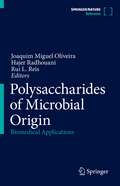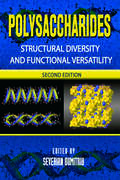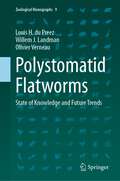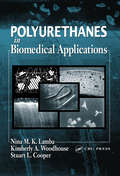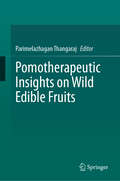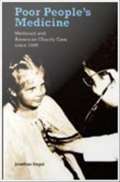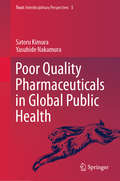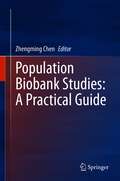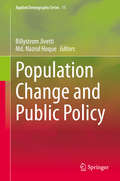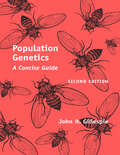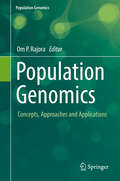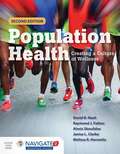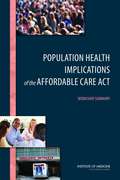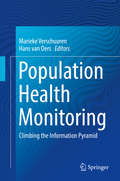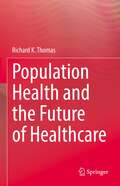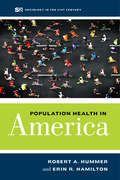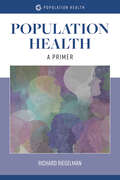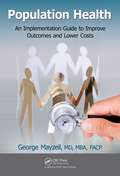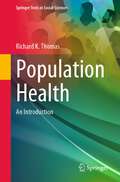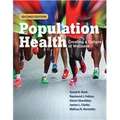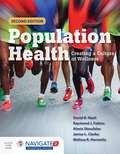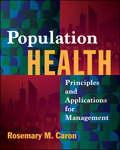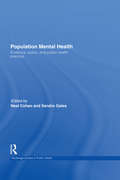- Table View
- List View
Polysaccharides of Microbial Origin: Biomedical Applications
by Rui L. Reis Joaquim Miguel Oliveira Hajer RadhouaniThis book provides a comprehensive analysis of microbial polysaccharides, their current uses, and highlights biomedical opportunities. The topics comprise principally a) their extraction, isolation, purification and advanced production processes; b) characterization of their structural, physicochemical, and biological properties, among others, by several techniques; c) description of the advanced functionalization and modification methods for the polysaccharide based-material; and d) their applications and uses in medical and pharmaceutical fields. Each chapter is written by world-renowned academics and practitioners on their field. This is an essential reference for students in biomedical, chemical, material, and microbiology engineering as well as researchers and professionals in the medical field.
Polysaccharides: Natural Fibers in Food and Nutrition
by Noureddine BenkebliaThis book reviews the evidence supporting the influence of plant fibers on our daily life by either having impacts on our nutrition or improving processed foods for human and animal feeding. By bringing new information and updating existing scientific data, this book will also be a consistent source of information for both professional and non-prof
Polysaccharides: Structural Diversity and Functional Versatility, Second Edition
by Severian DumitriuCompletely revised and expanded to reflect the latest advancements in the field, Polysaccharides: Structural Diversity and Functional Versatility, Second Edition outlines fundamental concepts in the structure, function, chemistry, and stability of polysaccharides and reveals new analytical techniques and applications currently impacting the cosmeti
Polystomatid Flatworms: State of Knowledge and Future Trends (Zoological Monographs #9)
by Louis H. du Preez Willem J. Landman Olivier VerneauThis unique book offers a comprehensive guide to the fascinating world of polystomatid flatworms. It introduces the reader to the individual life histories of polystomes and the chronological advances in our knowledge, with descriptions of species discovered over the past centuries. It equips newcomers to the field with basic protocols and techniques for collecting, processing and interpreting material. It also presents the history of research on this group of parasites, provides information on the discovery of each polystome and acknowledges the authors that have made major contributions. For the established researcher in the field, it offers a reference book containing taxonomic data, measurements and drawings of all known polystomes. The authors have brought together all the available material, creating a resource that will stimulate research and revive the global focus on this unique group of parasites. Thus, this work provides an essential reference for both established researchers and newcomers to the field.
Polyurethane Immobilization of Cells and Biomolecules: Medical and Environmental Applications
by T. ThomsonThis book provides a comprehensive review of the chemistry and research illustrating the benefits of polyurethane for immobilizing cells, with dozens of case studies in medical devices and environmental engineering.• Offers an essential resource for medical and environmental scientists• Provides a multidisciplinary and lucid writing style that uses little or no jargon• Extrapolates current technology into advanced areas, especially environmental remediation and medical devices• Fills the gap between immobilization research and practical applications
Polyurethanes in Biomedical Applications
by NinaM.K. LambaPolyurethanes in Biomedical Applications studies the use of polyurethanes in implanted medical devices. This analysis describes the concepts of polymer science, the manufacture of polyurethanes, and the biological responses to implant polyurethanes, reflecting the developments in biomaterials science and the interdisciplinary nature of bioengineering.
Pomotherapeutic Insights on Wild Edible Fruits
by Parimelazhagan ThangarajThis book uses an interdisciplinary approach that merges botany, nutrition and pharmacology to explore the potential of wild fruits. Wild edible fruits can have several therapeutic and health benefits which may vary depending on its nutritional content. These wild fruits are the major precursors to their commercial counterparts and also the major source of nutrition globally. Wild fruits are more essentially known for their bioactive components and beneficial effects of various phytochemicals. These phytochemicals have been associated with many health benefits and play a significant role in the prevention and management of various diseases. This book bridges the gap between natural therapeutic compounds and modern medicine. With a spotlight on their antioxidant, antidiabetic and other bioactivity and qualities, this comprehensive work delves deep into the bioactive compounds that make fruits veritable powerhouses of health benefits. This book primarily caters to the need of students and researchers pursuing studies in the fields of pharmacology, nutrition or natural medicine.
Poor People's Medicine: Medicaid and American Charity Care Since 1965
by Jonathan EngelPoor People's Medicine is a detailed history of Medicaid since its beginning in 1965. Federally aided and state-operated, Medicaid is the single most important source of medical care for the poorest citizens of the United States. From acute hospitalization to long-term nursing-home care, the nation's Medicaid programs pay virtually the entire cost of physician treatment, medical equipment, and prescription pharmaceuticals for the millions of Americans who fall within government-mandated eligibility guidelines. The product of four decades of contention over the role of government in the provision of health care, some of today's Medicaid programs are equal to private health plans in offering coordinated, high-quality medical care, while others offer little more than bare-bones coverage to their impoverished beneficiaries. Starting with a brief overview of the history of charity medical care, Jonathan Engel presents the debates surrounding Medicaid's creation and the compromises struck to allow federal funding of the nascent programs. He traces the development of Medicaid through the decades, as various states attempted to both enlarge the programs and more finely tailor them to their intended targets. At the same time, he describes how these new programs affected existing institutions and initiatives such as public hospitals, community clinics, and private pro bono clinical efforts. Along the way, Engel recounts the many political battles waged over Medicaid, particularly in relation to larger discussions about comprehensive health care and social welfare reform. Poor People's Medicine is an invaluable resource for understanding the evolution and present state of programs to deliver health care to America's poor.
Poor Quality Pharmaceuticals in Global Public Health (Trust #5)
by Satoru Kimura Yasuhide NakamuraThis book aims to clarify the global aspects of poor quality pharmaceuticals, generic products in particular, becoming complicated through the process of IMPACT (International Medical Products Anti-Counterfeiting Taskforce) organized by the initiative of the World Health Organization (WHO) in 2006. The findings from this book provide a long-term perspective to policymakers. This book discusses from the following points: industrial standardization, healthcare market accessibility, motivation on supply side, WHO medicines policy and intellectual property rights. Standardization regulates the quality and enabled the generic medicines spreading to developing/emerging countries through technology transfer. However, quality is a part of cost and reflected to price. When a healthcare service market is divided according to wealth gap, compliance to standardization for quality on supply side is divided accordingly. Thus, poor quality pharmaceuticals are prevalent worldwide. Generic pharmaceuticals are essential resources in public health. The WHO has been involved in the dispute around the intellectual property rights under its intention to promote the new drug development for neglected diseases. Global pandemic of AIDs is a critical factor to accelerate the confusion. This created feelings of distrust among developing/emerging countries against developed countries if the WHO was in favour of developed countries. In addition to that, an easy and optimistic start of IMPACT stirred up conflicts of interests in the international community. The problem of poor quality pharmaceuticals became more complicated through the conflicts on intellectual property rights; patented drugs to generic drugs. A key for quality generic products is the formation of a single healthcare service market where good motivation on supply side together with fair competitiveness with patented pharmaceuticals and equitable access to services (both for the rich and the poor) are ensured. Political commitment to investment and regulatory infrastructure for the market is crucial.
Population Biobank Studies: A Practical Guide
by Zhengming ChenThis book describes some of the key epidemiological principles, scientific approaches and quality assurance frameworks required to design and conduct biobank studies in various settings. Using examples from contemporary biobanks, the book addresses the design features and practical procedures needed in order to launch and manage biobank studies, including consent and regulatory approval, the organisation of field work, management of data and biological samples, follow-up and verification of disease outcomes, development of IT systems for data collection, quality assurance and study management. Over the last two decades, several large biobank studies have been initiated in different populations, intended to greatly enhance the development of precision medicine. Contemporary biobank studies are extremely large and complex, and involve several decades of follow-up. Such studies pose major challenges in terms of ensuring rapid recruitment, obtaining high-quality data, minimising loss to follow-up, reliably classifying disease outcomes, and optimising the use of the biological samples collected. In this regard, the key to success lies not in planning the perfect study, but in planning the most appropriate, reliable, sustainable and future-proof study given the practical constraints of available resources, time and capacity. The authors of this handbook are epidemiologists, clinicians, software engineers, and laboratory and data scientists with extensive experience in conducting large biobank studies. The eight chapters can be read separately or together, and provide readers with essential information on how to design, implement and manage these studies. The state-of-the-art, innovative and scalable approaches and methodologies presented here are intended to stimulate the development of further population-based and hospital-based biobank studies in diverse populations.
Population Change and Public Policy (Applied Demography Series #11)
by Billystrom Jivetti Md. Nazrul HoqueThis book provides a solid empirical portrait based on the complexities of demographic components of population change. It describes recent innovations, trends, challenges and solutions to population change and public policy issues, such as but not limited to immigration, gender discrimination in the labor market, student housing, teen pregnancy programs, smoking and alcohol consumption, and environment and self-rated health. As such it provides an interesting platform for academics, researchers, policy makers, and students to explore experiences and research findings on special topics in applied demography and how those inform the field of population studies and public policy.
Population Genetics: A Concise Guide
by John H. GillespieThis concise introduction offers students and researchers an overview of the discipline that connects genetics and evolution. Addressing the theories behind population genetics and relevant empirical evidence, John Gillespie discusses genetic drift, natural selection, nonrandom mating, quantitative genetics, and the evolutionary advantage of sex. First published to wide acclaim in 1998, this brilliant primer has been updated to include new sections on molecular evolution, genetic drift, genetic load, the stationary distribution, and two-locus dynamics. This book is indispensable for students working in a laboratory setting or studying free-ranging populations.
Population Genomics: Concepts, Approaches and Applications (Population Genomics)
by Om P. RajoraPopulation genomics has revolutionized various disciplines of biology including population, evolutionary, ecological and conservation genetics, plant and animal breeding, human health, medicine and pharmacology by allowing to address novel and long-standing questions with unprecedented power and accuracy. It employs large-scale or genome-wide genetic information and bioinformatics to address various fundamental and applied aspects in biology and related disciplines, and provides a comprehensive genome-wide perspective and new insights that were not possible before. These advances have become possible due to the development of new and low-cost sequencing and genotyping technologies and novel statistical approaches and software, bioinformatics tools, and models. Population genomics is tremendously advancing our understanding the roles of evolutionary processes, such as mutation, genetic drift, gene flow, and natural selection, in shaping up genetic variation at individual loci and across the genome and populations; improving the assessment of population genetic parameters or processes such as adaptive evolution, effective population size, gene flow, admixture, inbreeding and outbreeding depression, demography, and biogeography; resolving evolutionary histories and phylogenetic relationships of extant, ancient and extinct species; understanding the genomic basis of fitness, adaptation, speciation, complex ecological and economically important traits, and disease and insect resistance; facilitating forensics, genetic medicine and pharmacology; delineating conservation genetic units; and understanding the genetic effects of resource management practices, and assisting conservation and sustainable management of genetic resources.This Population Genomics book discusses the concepts, approaches, applications and promises of population genomics in addressing most of the above fundamental and applied crucial aspects in a variety of organisms from microorganisms to humans. The book provides insights into a range of emerging population genomics topics including population epigenomics, landscape genomics, seascape genomics, paleogenomics, ecological and evolutionary genomics, biogeography, demography, speciation, admixture, colonization and invasion, genomic selection, and plant and animal domestication. This book fills a vacuum in the field and is expected to become a primary reference in Population Genomics world-wide.
Population Health Creating a Culture of Wellness
by David B. Nash Raymond J. Fabius Alexis Skoufalos Janice L. ClarkePracticing population based care is a central focus of the Affordable Care Act and a key component of implementing health reform. Wellness and Prevention, Accountable Care Organizations, Patient Centered Medical Homes, Comparative Effectiveness Research, and Patient Engagement have become common terms in the healthcare lexicon. Aimed at students and practitioners in health care settings, the Second Edition of Population Health: Creating a Culture of Wellness, conveys the key concepts of concepts of population health management and strategies for creating a culture of health and wellness in the context of health care reform. <p><p>Beginning with a new opening chapter, entitled, “Building Cultures of Health and Wellness”, the Second Edition takes a comprehensive, forward-looking approach to population health with an emphasis on creating a culture of wellness. The revised text takes into consideration the Affordable Care Act and its substantial impact on how health science is taught, how health care is delivered and how health care services are compensated in the United States. <p><p>Key Features: - Study and discussion questions are provided at the conclusion of each chapter to highlight key learning objectives and readings. - Case studies highlight real world applications of concepts and strategies, and links to web sites provide additional opportunities for expanding knowledge. - Each chapter can stand alone to highlight key population health issues and provide strategies to address them, allowing educators to choose specific chapters or sections that meet the learning objectives of the course. - Each new print copy includes Navigate 2 Advantage Access that unlocks a comprehensive and interactive eBook, student practice activities and assessments, a full suite of instructor resources, and learning analytics reporting tools.
Population Health Implications of the Affordable Care Act
by Institute of Medicine Board on Population Health and Public Health Practice Joe Alper Roundtable on Population Health ImprovementPopulation Health Implications of the Affordable Care Act is the summary of a workshop convened in June 2013 by the Institute of Medicine Roundtable on Population Health Improvement to explore the likely impact on population health improvement of various provisions within the Affordable Care Act (ACA). This public workshop featured presentations and discussion of the impact of various provisions in the ACA on population health improvement. Several provisions of the ACA offer an unprecedented opportunity to shift the focus of health experts, policy makers, and the public beyond health care delivery to the broader array of factors that play a role in shaping health outcomes. The shift includes a growing recognition that the health care delivery system is responsible for only a modest proportion of what makes and keeps Americans healthy and that health care providers and organizations could accept and embrace a richer role in communities, working in partnership with public health agencies, community-based organizations, schools, businesses, and many others to identify and solve the thorny problems that contribute to poor health. Population Health Implications of the Affordable Care Act looks beyond narrow interpretations of population as the group of patients covered by a health plan to consider a more expansive understanding of population, one focused on the distribution of health outcomes across all individuals living within a certain set of geopolitical boundaries. In establishing the National Prevention, Health Promotion, and Public Health Council, creating a fund for prevention and public health, and requiring nonprofit hospitals to transform their concept of community benefit, the ACA has expanded the arena for interventions to improve health beyond the "doctor's" office. Improving the health of the population - whether in a community or in the nation as a whole - requires acting to transform the places where people live, work, study, and play. This report examines the population health-oriented efforts of and interactions among public health agencies (state and local), communities, and health care delivery organizations that are beginning to facilitate such action.
Population Health Monitoring: Climbing The Information Pyramid
by Marieke Verschuuren Hans Van OersThis timely volume presents an in-depth tour of population health monitoring—what it is, what it does, and why it has become increasingly important to health information systems across Europe. Introductory chapters ground readers in the structures of health information systems, and the main theoretical and conceptual models of population health monitoring. From there, contributors offer tools and guidelines for optimum monitoring, including best practices for gathering and contextualizing data and for disseminating findings, to benefit the people most affected by the information. And an extended example follows the step-by-step processes of population health monitoring through a study of health inequalities, from data collection to policy recommendations. Included in the coverage: · Structuring health information: frameworks, models, and indicators · Analysis: contextualization of process and content · Knowledge translation: key concepts, terms, and activities · Health inequality monitoring: a practical application of population health monitoring · Relating population health monitoring to other types of health assessments · Population health monitoring: strengths, weaknesses, opportunities, and threats A robust guide with international implications for an emerging field, Population Health Monitoring is a salient reference for public health experts working in the field of health information as well as post-graduate public health students and public health policymakers. "In this comprehensive and easy to read volume, Verschuuren and van Oers, accompanied by other specialists in the field, present a fresh and thoroughly researched contribution on the discipline of population health monitoring. They critically analyse and describe the phases, functions and approaches to population health monitoring but far more importantly, the discipline is positioned within the wider domains of public health, health policy and health systems. The book is definitely highly recommended reading for students of public health and health services management but is also a useful refresher course for public health practitioners."Natasha Azzopardi Muscat, President, European Public Health AssociationChapter 7 of this book is available open access under a CC BY 3.0 IGO license at link.springer.comChapter 8 of this book is available open access under a CC BY 3.0 IGO license at link.springer.com
Population Health and the Future of Healthcare
by Richard K. ThomasStarting with a working definition, this comprehensive work defines the attributes of the population health model. It clarifies what population health is and is not. It discusses health disparities and the social determinants of health and illness and provides new ways of moving forward towards a more sustainable healthcare model in a changing society, thereby pointing out the importance of multi-sector collaboration for collective impact for community health improvement. The book takes this further by providing sources of data to support the population health model. As such, this book provides a must-read for students and anyone working, teaching or consulting in population healthcare.
Population Health in America (Sociology in the Twenty-First Century #5)
by Robert A. Hummer Erin R. HamiltonIn this engaging and accessibly written book, Population Health in America weaves demographic data with social theory and research to help students understand health patterns and trends in the U.S. population. While life expectancy was estimated to be just 37 years in the United States in 1870, today it is more than twice as long, at over 78 years. Yet today, life expectancy in the U.S. lags behind almost all other wealthy countries. Within the U.S., there are substantial social inequalities in health and mortality: women live longer but less healthier lives than men; African Americans and Native Americans live far shorter lives than Asian Americans and White Americans; and socioeconomic inequalities in health have been widening over the past 20 years. What accounts for these population health patterns and trends? Inviting students to delve into population health trends and disparities, demographers Robert Hummer and Erin Hamilton provide an easily understandable historical and contemporary portrait of U.S. population health. Perfect for courses such as population health, medical or health sociology, social epidemiology, health disparities, demography, and others, as well as for academic researchers and lay persons interested in better understanding the overall health of the country, Population Health in America also challenges students, academics, and the public to understand current health policy priorities and to ask whether considerably different directions are needed.
Population Health: A Primer
by Richard RiegelmanPopulation health is rapidly becoming an overarching umbrella for connecting the clinical health professions, traditional public health, and health administration and policy. Population Health: A Primer provides an overview of population health including key concepts and approaches needed to build an educational foundation for this rapidly emerging field. The text begins with an overview of population health and why it matters before providing a step-by-step approach to thinking in systems and covering the basic tools of population health. Case studies throughout illustrate the application of approaches for addressing population health issues. A helpful instructor's guide suggests options for using the Primer in short courses, as part of a larger course, or as individual units.
Population Health: An Implementation Guide to Improve Outcomes and Lower Costs
by MD, MBA, MayzellAs healthcare moves from volume to value, payment models and delivery systems will need to change their focus from the individual patient to a population orientation. This will move our economic model from that of a "sick system" to a system of care focused on prevention, boosting patient engagement, and reducing medical expenditures. This new focu
Population Health: An Introduction (Springer Texts in Social Sciences)
by Richard K. ThomasThis book provides a basic understanding and concise overview of the nature of population health, the factors that make a new paradigm necessary, and the attributes associated with this unique approach to community health improvement. Written in a very accessible way, the book describes the definition of population health, the attributes of population health, and what population health is and is not. It emphasizes the extent to which the population health model revolutionizes the approach to community health improvement within a contemporary context, beginning with a redefining of such common concepts as “health”, “healthcare”, “health status”, and “health needs assessment”. As such, this book is a valuable read for practitioners and professionals who need to be familiar with the population health approach but are not likely to try to implement it.
Population Health: Creating a Culture of Wellness
by David B. Nash Janice Clarke Raymond J. Fabius Alexis Skoufalos Melissa R. HorowitzPracticing population based care is a central focus of the Affordable Care Act and a key component of implementing health reform. Wellness and Prevention, Accountable Care Organizations, Patient Centered Medical Homes, Comparative Effectiveness Research, and Patient Engagement have become common terms in the healthcare lexicon. Aimed at students and practitioners in health care settings, the Second Edition of Population Health: Creating a Culture of Wellness, conveys the key concepts of concepts of population health management and strategies for creating a culture of health and wellness in the context of health care reform. Beginning with a new opening chapter, entitled, "Building Cultures of Health and Wellness", the Second Edition takes a comprehensive, forward-looking approach to population health with an emphasis on creating a culture of wellness.
Population Health: Creating a Culture of Wellness
by David B. Nash Raymond J. Fabius Alexis Skoufalos Janice L. ClarkePracticing population based care is a central focus of the Affordable Care Act and a key component of implementing health reform. Wellness and Prevention, Accountable Care Organizations, Patient Centered Medical Homes, Comparative Effectiveness Research, and Patient Engagement have become common terms in the healthcare lexicon. Aimed at students and practitioners in health care settings, the Second Edition of Population Health: Creating a Culture of Wellness, conveys the key concepts of concepts of population health management and strategies for creating a culture of health and wellness in the context of health care reform. Beginning with a new opening chapter, entitled, “Building Cultures of Health and Wellness”, the Second Edition takes a comprehensive, forward-looking approach to population health with an emphasis on creating a culture of wellness. The revised text takes into consideration the Affordable Care Act and its substantial impact on how health science is taught, how health care is delivered and how health care services are compensated in the United States. Key Features: - Study and discussion questions are provided at the conclusion of each chapter to highlight key learning objectives and readings. - Case studies highlight real world applications of concepts and strategies, and links to web sites provide additional opportunities for expanding knowledge. - Each chapter can stand alone to highlight key population health issues and provide strategies to address them, allowing educators to choose specific chapters or sections that meet the learning objectives of the course. - Each new print copy includes Navigate 2 Advantage Access that unlocks a comprehensive and interactive eBook, student practice activities and assessments, a full suite of instructor resources, and learning analytics reporting tools.
Population Health: Principles And Applications For Management (Gateway to Healthcare Management)
by Rosemary CaronInstructor Resources: Test bank; presentation PowerPoint slides, answer guides to discussion questions, exercises, and assignments, and resource lists. The field of population health examines a diverse range of environmental, physical, and cultural conditions that occur within populations; considers the health outcomes influenced by these conditions; and seeks the development of policies and interventions to improve health and minimize health inequities in an efficient and affordable manner. Population Health: Principles and Applications for Management provides the building blocks for taking a population health approach, which represents a new way of promoting health, preventing disease, and navigating public health and healthcare challenges in an ever-changing environment. The book explains the key principles, skills, and applications of public health; describes how a healthcare administrator can use epidemiology, the basic science of public health, to understand and address the needs of communities; and then synthesizes this information to provide an introduction to population health management. Key topics include the following: The core functions of public health Public health system organization Descriptive and analytic epidemiology Health determinants and their impacts Methods for assessing the health of a community Applications of managerial epidemiology Elements of a data-driven approach to population health Bolstered by a variety of case studies and exercises, this book provides students with a conceptual framework that can be further developed and expanded through subsequent experiences in the workplace. Although the specific public health and healthcare issues facing communities will inevitably change over time, this framework will remain essential to efforts to improve the health of populations.
Population Mental Health: Evidence, Policy, and Public Health Practice
by Sandro Galea Neal CohenFirst Published in 2012. Routledge is an imprint of Taylor & Francis, an informa company.
